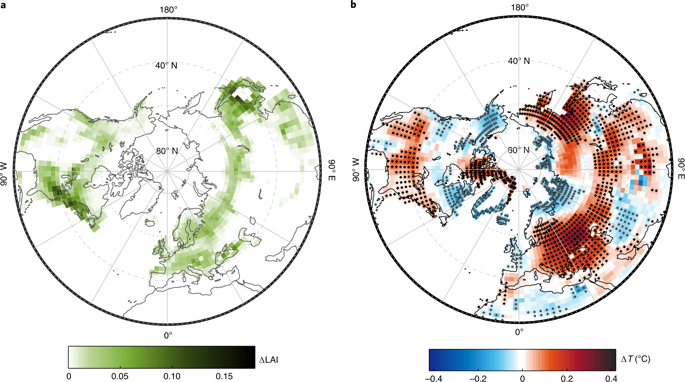Nature Climate Change ( IF 30.7 ) Pub Date : 2020-02-17 , DOI: 10.1038/s41558-020-0713-4 Xiyan Xu , William J. Riley , Charles D. Koven , Gensuo Jia , Xiaoyan Zhang

|
Earlier leaf-out in response to climate warming has been recorded in northern temperate and boreal regions. In turn, this shift modifies climate by altering seasonal cycles of surface energy, water and carbon budgets. Here, we use the Community Earth System Model 1.2 to investigate climate feedbacks from advanced leaf-out in northern temperate and boreal vegetation. An imposed 12-day earlier leaf-out in this region, consistent with recent observations, enhances annual surface warming in the Northern Hemisphere. We identify warming hotspots in the Canadian Arctic Archipelago (~0.7 °C), east and west edges of Siberia (~0.4 °C) and southeastern Tibetan Plateau (~0.3 °C). We attribute this enhanced warming to combined effects of indirect water vapour, cloud and snow-albedo radiative feedbacks through intensified poleward water vapour transport rather than direct vegetation albedo and latent heat biophysical feedbacks. With continued warming, positive feedbacks between climate and leaf phenology are likely to amplify warming in the northern high latitudes.
中文翻译:

较早的离开温暖了北方的空气
在北部温带和北方地区,已记录出因气候变暖而较早离开的现象。反过来,这种转变通过改变表面能,水和碳预算的季节性周期来改变气候。在这里,我们使用社区地球系统模型1.2来调查北部温带和北方植被中高级叶的气候反馈。与最近的观察结果一致,该地区提前12天进行叶面放牧可增强北半球的年度地表升温。我们确定了加拿大北极群岛(〜0.7°C),西伯利亚的东西两侧(〜0.4°C)和青藏高原东南部(〜0.3°C)的升温热点。我们将这种变暖现象归因于间接水蒸气的综合作用,云和雪反照率的辐射反馈通过加剧的极向水汽传输而不是直接植被反照率和潜热生物物理反馈来实现。随着持续变暖,气候和叶片物候之间的积极反馈可能会加剧北部高纬度地区的变暖。


























 京公网安备 11010802027423号
京公网安备 11010802027423号